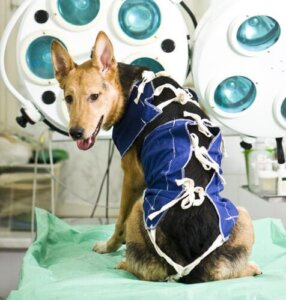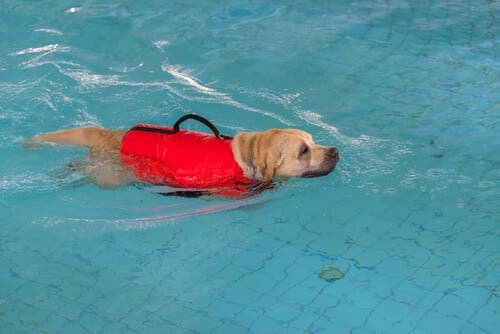Tips for Pet Rehabilitation: Helping Your Pet Recover


Written and verified by the lawyer Francisco María García
At some point in their lives, pets can have accidents or events that compromise their health. However, once they are over the worst of these problems, your pet may need pet rehabilitation sessions. Your vet will tell you if your pet needs this.
However, your pet rehabilitation sessions will be more effective if you have all the information about these types of treatments. Here are some guidelines to keep in mind.
Why is pet rehabilitation necessary?
Vets recommend pet rehabilitation or physiotherapy for different purposes. However, everything will depend on the condition and situation of the animal. Next, we’ll look at some typical examples:
- Full recovery from an injury following an accident or a detrimental event.
- Recovery after a major surgical intervention or to accelerate recovery and improve pain or inflammation
- Neurological or orthopedic issues
- Preventing damage to the animal’s physiology, such as muscle atrophy following periods of immobility
- Reduce or eliminate the possibility of being permanently disabled
- Eliminate or alleviate further diseases
- Strengthening following loss of muscle mass
- Guarantee the quality of life of the pet
What is pet rehabilitation like?
Pet rehabilitation includes a number of sessions with a specialist that your pet will go to during regular periods. Sessions are usually between one hour and an hour and a half. The therapist may recommend sessions several times a week.

Some techniques are passive in the sense that the therapists perform the techniques on the animal. However, other techniques are active and your pet needs to perform these actions on their own.
There are many different types of exercises for pet rehabilitation. For example:
- Active and passive exercises. These are various types of exercises to condition muscles, tendons, and bones.
- Cold and heat. Some therapies aimed at healing muscle conditions involve applying cold or heat, either through compresses or baths.
- Massages. There are similar therapeutic benefits to massage in humans. However, you need a trained animal masseuse to account for physiological differences.
- Hydrotherapy. The pressure exerted by water, whether applied directly or through immersion, offers benefits.
- Other therapies. Experts use certain technology to perform rehabilitation in both humans and animals. For example, some therapists use laser therapy, ultrasounds, or electricity.
Tips during your pet’s rehabilitation
Now, we’ll give you some suggestions for owners whose pets are in a physical therapy program. These recommendations are important for successful rehabilitation and restoring your pet to full health.

During rehabilitation sessions:
- Go with your pet to all their sessions. This will help your pet feel safe, less stressed, and emotionally supported. As a result, this will help your pet heal faster.
- Don’t skip sessions! In fact, missing sessions can undo all the hard work and can cause you to start from the beginning again. This also makes the recovery process take longer than necessary.
- Ask questions! You can even write down any questions that come up to make sure that you’re doing everything you can for your pet.
At home:
- Do any exercises that the therapist recommends you do at home. Also, make any necessary lifestyle changes for your pet. Especially consider any possible issues with your pet’s physical mobility.
- Make sure your pet takes any prescribed medication. These are an important part of the recovery process. Failure to give your pet the medication as prescribed could hinder their healing.
- Don’t let your pet do anything that the therapist prohibits. Take these prohibitions seriously, as they are part of the rehabilitation program.
- Give your pet lots of love and affection. If your pet feels loved and safe, they will have a stronger desire to get healthy. This can affect their progress. You also need to make sure that your pet is comfortable and clean, as this can also reduce stress.
- While your pet is undergoing rehabilitation, you also need to keep a close eye on their health. Make sure you’re aware of food intake, urination and bowel movements, and their mood.
After rehabilitation:
- Make sure that your pet is fully healed and meets all goals of the rehabilitation program. In fact, once you finish the program, you’ll need to schedule another appointment with your vet. Then, the vet can confirm that the rehabilitation was successful.
Following these recommendations will increase the likelihood that your pet will successfully finish rehabilitation and make a full recovery.
At some point in their lives, pets can have accidents or events that compromise their health. However, once they are over the worst of these problems, your pet may need pet rehabilitation sessions. Your vet will tell you if your pet needs this.
However, your pet rehabilitation sessions will be more effective if you have all the information about these types of treatments. Here are some guidelines to keep in mind.
Why is pet rehabilitation necessary?
Vets recommend pet rehabilitation or physiotherapy for different purposes. However, everything will depend on the condition and situation of the animal. Next, we’ll look at some typical examples:
- Full recovery from an injury following an accident or a detrimental event.
- Recovery after a major surgical intervention or to accelerate recovery and improve pain or inflammation
- Neurological or orthopedic issues
- Preventing damage to the animal’s physiology, such as muscle atrophy following periods of immobility
- Reduce or eliminate the possibility of being permanently disabled
- Eliminate or alleviate further diseases
- Strengthening following loss of muscle mass
- Guarantee the quality of life of the pet
What is pet rehabilitation like?
Pet rehabilitation includes a number of sessions with a specialist that your pet will go to during regular periods. Sessions are usually between one hour and an hour and a half. The therapist may recommend sessions several times a week.

Some techniques are passive in the sense that the therapists perform the techniques on the animal. However, other techniques are active and your pet needs to perform these actions on their own.
There are many different types of exercises for pet rehabilitation. For example:
- Active and passive exercises. These are various types of exercises to condition muscles, tendons, and bones.
- Cold and heat. Some therapies aimed at healing muscle conditions involve applying cold or heat, either through compresses or baths.
- Massages. There are similar therapeutic benefits to massage in humans. However, you need a trained animal masseuse to account for physiological differences.
- Hydrotherapy. The pressure exerted by water, whether applied directly or through immersion, offers benefits.
- Other therapies. Experts use certain technology to perform rehabilitation in both humans and animals. For example, some therapists use laser therapy, ultrasounds, or electricity.
Tips during your pet’s rehabilitation
Now, we’ll give you some suggestions for owners whose pets are in a physical therapy program. These recommendations are important for successful rehabilitation and restoring your pet to full health.

During rehabilitation sessions:
- Go with your pet to all their sessions. This will help your pet feel safe, less stressed, and emotionally supported. As a result, this will help your pet heal faster.
- Don’t skip sessions! In fact, missing sessions can undo all the hard work and can cause you to start from the beginning again. This also makes the recovery process take longer than necessary.
- Ask questions! You can even write down any questions that come up to make sure that you’re doing everything you can for your pet.
At home:
- Do any exercises that the therapist recommends you do at home. Also, make any necessary lifestyle changes for your pet. Especially consider any possible issues with your pet’s physical mobility.
- Make sure your pet takes any prescribed medication. These are an important part of the recovery process. Failure to give your pet the medication as prescribed could hinder their healing.
- Don’t let your pet do anything that the therapist prohibits. Take these prohibitions seriously, as they are part of the rehabilitation program.
- Give your pet lots of love and affection. If your pet feels loved and safe, they will have a stronger desire to get healthy. This can affect their progress. You also need to make sure that your pet is comfortable and clean, as this can also reduce stress.
- While your pet is undergoing rehabilitation, you also need to keep a close eye on their health. Make sure you’re aware of food intake, urination and bowel movements, and their mood.
After rehabilitation:
- Make sure that your pet is fully healed and meets all goals of the rehabilitation program. In fact, once you finish the program, you’ll need to schedule another appointment with your vet. Then, the vet can confirm that the rehabilitation was successful.
Following these recommendations will increase the likelihood that your pet will successfully finish rehabilitation and make a full recovery.
This text is provided for informational purposes only and does not replace consultation with a professional. If in doubt, consult your specialist.








